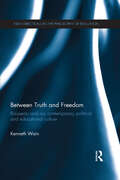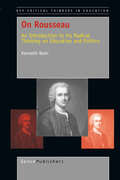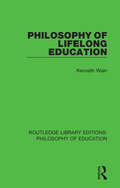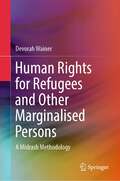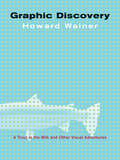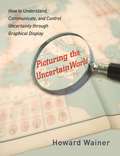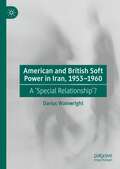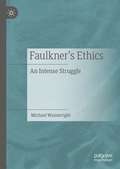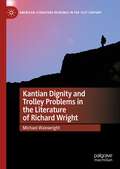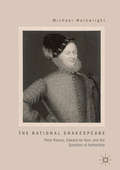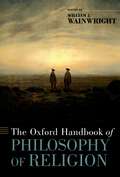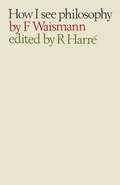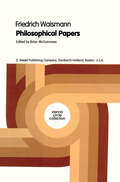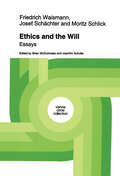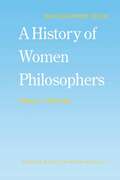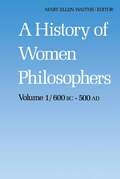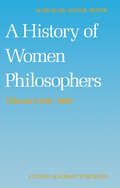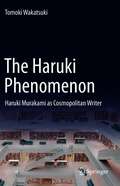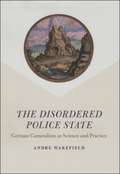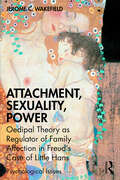- Table View
- List View
Between Truth and Freedom: Rousseau and our contemporary political and educational culture (New Directions in the Philosophy of Education)
by Kenneth WainThis book engages in a broad reading of Rousseau’s writings on educational and political thought in order to explore and address the competing demands of the enculturation and individuation of the young in Western societies. Although Rousseau’s Emile has been frequently utilised in educational debate, much of his other work has been largely neglected, as too has the relationship between his educational and political thinking, which this work seeks to redress. Drawing on the thinking of philosophers Foucault and Richard Rorty, the book considers the public and private conflicts of education and politics in modern societies, treating them as the tension between the demands of truth and freedom. This tension exists across a range of educational and political systems, such as teaching in and by the family, school, the government and, separately, for women. Wain suggests that the conflict between truth and freedom began with Rousseau and remains a central challenge in our contemporary world of political and educational thought. This book’s examination of the public and private roles in education and politics can enhance our understanding of modern educational systems and current political nihilism. Between Truth and Freedom provides an analysis of Rousseau’s position on the politics of education, arguing that his thoughts were much wider and more sophisticated than the ideas presented in Emile imply. This new consideration of the work of a classic figure will appeal to researchers and academics in the fields of the philosophy of education and political education.
Between Truth and Freedom: Rousseau and our contemporary political and educational culture (New Directions in the Philosophy of Education)
by Kenneth WainThis book engages in a broad reading of Rousseau’s writings on educational and political thought in order to explore and address the competing demands of the enculturation and individuation of the young in Western societies. Although Rousseau’s Emile has been frequently utilised in educational debate, much of his other work has been largely neglected, as too has the relationship between his educational and political thinking, which this work seeks to redress. Drawing on the thinking of philosophers Foucault and Richard Rorty, the book considers the public and private conflicts of education and politics in modern societies, treating them as the tension between the demands of truth and freedom. This tension exists across a range of educational and political systems, such as teaching in and by the family, school, the government and, separately, for women. Wain suggests that the conflict between truth and freedom began with Rousseau and remains a central challenge in our contemporary world of political and educational thought. This book’s examination of the public and private roles in education and politics can enhance our understanding of modern educational systems and current political nihilism. Between Truth and Freedom provides an analysis of Rousseau’s position on the politics of education, arguing that his thoughts were much wider and more sophisticated than the ideas presented in Emile imply. This new consideration of the work of a classic figure will appeal to researchers and academics in the fields of the philosophy of education and political education.
On Rousseau: An Introduction to his Radical Thinking on Education and Politics (Key Critical Thinkers in Education #3)
by Kenneth WainFew would want to dispute that Jean-Jacques Rousseau was one of the most fascinating figures of the Enlightenment; a man whose interests ranged over a variety of subjects, from politics, to education, to music, to botany. He was also one of the most contradictory and controversial thinkers and exciting writers of his time; the writer of the first modern autobiography and author of the best-selling novel of his day. Emile was among his most celebrated works, a book he regarded as his crowning achievement. Its revolutionary ideas have influenced radical thinkers and made him famous with generations of educators right into the twentieth century. Rousseau made other contributions to education, but his more political works on the subject are usually ignored by commentators. There has been no shortage of books about him in recent years, including general introductory ones. But a comprehensive introductory book dealing with all the aspects of his thoughts about education and politics has long been overdue. On Rousseau: An Introduction to his Radical Thinking on Education and Politics fills this void, and should interest educators, educators of educators, philosophy students, and all with a general interest in education and politics and the history of ideas.
Philosophy of Lifelong Education (Routledge Library Editions: Philosophy of Education)
by Kenneth WainThis book, first published in 1987, provides a rigorous philosophical analysis of lifelong education. The author presents his arguments simply and directly so that the book is accessible to students who are new to philosophy and adult education.
Philosophy of Lifelong Education (Routledge Library Editions: Philosophy of Education)
by Kenneth WainThis book, first published in 1987, provides a rigorous philosophical analysis of lifelong education. The author presents his arguments simply and directly so that the book is accessible to students who are new to philosophy and adult education.
Human Rights for Refugees and Other Marginalised Persons: A Midrash Methodology
by Devorah WainerThis book provides a new framework for conducting qualitative research into Asylum Seeking Refugees based on Emmanuel Levinas’ ethic of the face-to-face encounter. The methodology originates in the term Midrash—a narrative form that exposes; investigates; searches. It reconceptualises encounters between Asylum Seeking Refugees and those researching their experiences in a manner that moves beyond the possibility of ‘Othering’ and the removal of ‘voice’ that can characterise research into refugees. This methodology allows a complex and rich multidimensional text, with heterogeneity of voices, experiences, and subjects. As a phenomenological method of research, the internal phenomena of the researcher—feeling, intuition, and personal perception—are legitimate sites of knowledge and understanding, and are not considered separate from the external, objectively observable world. While the researcher is not researching herself, she is also not separate from the research field and data. The Midrash methodology is an honest and explicit method of research designed to (re)invigorated the passion of academics and researchers.
Graphic Discovery: A Trout in the Milk and Other Visual Adventures
by Howard WainerGood graphs make complex problems clear. From the weather forecast to the Dow Jones average, graphs are so ubiquitous today that it is hard to imagine a world without them. Yet they are a modern invention. This book is the first to comprehensively plot humankind's fascinating efforts to visualize data, from a key seventeenth-century precursor--England's plague-driven initiative to register vital statistics--right up to the latest advances. In a highly readable, richly illustrated story of invention and inventor that mixes science and politics, intrigue and scandal, revolution and shopping, Howard Wainer validates Thoreau's observation that circumstantial evidence can be quite convincing, as when you find a trout in the milk. The story really begins with the eighteenth-century origins of the art, logic, and methods of data display, which emerged, full-grown, in William Playfair's landmark 1786 trade atlas of England and Wales. The remarkable Scot singlehandedly popularized the atheoretical plotting of data to reveal suggestive patterns--an achievement that foretold the graphic explosion of the nineteenth century, with atlases published across the observational sciences as the language of science moved from words to pictures. Next come succinct chapters illustrating the uses and abuses of this marvelous invention more recently, from a murder trial in Connecticut to the Vietnam War's effect on college admissions. Finally Wainer examines the great twentieth-century polymath John Wilder Tukey's vision of future graphic displays and the resultant methods--methods poised to help us make sense of the torrent of data in our information-laden world.
Picturing the Uncertain World: How to Understand, Communicate, and Control Uncertainty through Graphical Display
by Howard WainerIn his entertaining and informative book Graphic Discovery, Howard Wainer unlocked the power of graphical display to make complex problems clear. Now he's back with Picturing the Uncertain World, a book that explores how graphs can serve as maps to guide us when the information we have is ambiguous or incomplete. Using a visually diverse sampling of graphical display, from heartrending autobiographical displays of genocide in the Kovno ghetto to the "Pie Chart of Mystery" in a New Yorker cartoon, Wainer illustrates the many ways graphs can be used--and misused--as we try to make sense of an uncertain world.Picturing the Uncertain World takes readers on an extraordinary graphical adventure, revealing how the visual communication of data offers answers to vexing questions yet also highlights the measure of uncertainty in almost everything we do. Are cancer rates higher or lower in rural communities? How can you know how much money to sock away for retirement when you don't know when you'll die? And where exactly did nineteenth-century novelists get their ideas? These are some of the fascinating questions Wainer invites readers to consider. Along the way he traces the origins and development of graphical display, from William Playfair, who pioneered the use of graphs in the eighteenth century, to instances today where the public has been misled through poorly designed graphs. We live in a world full of uncertainty, yet it is within our grasp to take its measure. Read Picturing the Uncertain World and learn how.
American and British Soft Power in Iran, 1953-1960: A 'Special Relationship'?
by Darius WainwrightThis book offers a distinctive approach to understanding Anglo-American relations with Iran in the early Cold War. It establishes how the United Kingdom and United States used soft power between 1953 and 1960 to combat communism and promote their respective ways of life in Iran. It identifies their motives, the types of initiatives employed, and the extent to which they perceived their policies to be a success. It is a historical case study through which wider conclusions regarding UK and US foreign policy can be drawn. As well as illustrating the competitive tensions within the Anglo-American 'special relationship', it highlights the role of individuals in the making and shaping of diplomatic endeavours. More broadly, the analysis of UK and US interactions in Iran through the prism of soft power underlines that there was more to both countries’ Cold War foreign policies than the containment of communism.
Faulkner’s Ethics: An Intense Struggle
by Michael WainwrightThis book offers the first comprehensive investigation of ethics in the canon of William Faulkner. As the fundamental framework for its analysis of Faulkner’s fiction, this study draws on The Methods of Ethics, the magnum opus of the utilitarian philosopher Henry Sidgwick. While Faulkner’s Ethics does not claim that Faulkner read Sidgwick’s work, this book traces Faulkner’s moral sensitivity. It argues that Faulkner’s language is a moral medium that captures the ways in which people negotiate the ethical demands that life places on them. Tracing the contours of this evolving medium across six of the author’s major novels, it explores the basic precepts set out in The Methods of Ethics with the application of more recent contributions to moral philosophy, especially those of Jacques Derrida and Derek Parfit.
Kantian Dignity and Trolley Problems in the Literature of Richard Wright (American Literature Readings in the 21st Century)
by Michael WainwrightThis book examines the literature of African-American author Richard Wright and the philosophy of Immanuel Kant, arguing that Wright was not only the foremost proponent of minoritarian protest literature, but also a groundbreaking minoritarian exponent of philosophical literature. In presenting this argument, the volume defends trolley problems from the criticism that some philosophers level against them by promoting their use as an interpretive tool for literary scholars. Starting with Martha C. Nussbaum’s interventions in literary theory concerning Henry James and perceptive equilibrium, this book draws on the philosophical thoughts of her contemporaries—Philippa Foot, John Rawls, Judith Jarvis Thomson, and Derek Parfit—to analyze Uncle Tom’s Children, especially “Down by the Riverside,” alongside other works by Wright. This approach emphasizes Wright’s recognition of the importance and integrity of Kant’s concept of dignity.
The Rational Shakespeare: Peter Ramus, Edward de Vere, and the Question of Authorship
by Michael WainwrightThe Rational Shakespeare: Peter Ramus, Edward de Vere, and the Question of Authorship examines William Shakespeare’s rationality from a Ramist perspective, linking that examination to the leading intellectuals of late humanism, and extending those links to the life of Edward de Vere, Seventeenth Earl of Oxford. The application to Shakespeare’s plays and sonnets of a game-theoretic hermeneutic, an interpretive approach that Ramism suggests but ultimately evades, strengthens these connections in further supporting the Oxfordian answer to the question of Shakespearean authorship.
The Rational Shakespeare: Peter Ramus, Edward de Vere, and the Question of Authorship
by Michael WainwrightThe Rational Shakespeare: Peter Ramus, Edward de Vere, and the Question of Authorship examines William Shakespeare’s rationality from a Ramist perspective, linking that examination to the leading intellectuals of late humanism, and extending those links to the life of Edward de Vere, Seventeenth Earl of Oxford. The application to Shakespeare’s plays and sonnets of a game-theoretic hermeneutic, an interpretive approach that Ramism suggests but ultimately evades, strengthens these connections in further supporting the Oxfordian answer to the question of Shakespearean authorship.
The Oxford Handbook of Philosophy of Religion (Oxford Handbooks)
by William J. WainwrightThe Oxford Handbook of Philosophy of Religion contains newly commissioned chapters by 21 prominent experts who cover the field in a comprehensive but accessible manner. Each chapter is expository, critical, and representative of a distinctive viewpoint.
The Oxford Handbook of Philosophy of Religion (Oxford Handbooks)
by William J WainwrightThe Oxford Handbook of Philosophy of Religion contains newly commissioned chapters by 21 prominent experts who cover the field in a comprehensive but accessible manner. Each chapter is expository, critical, and representative of a distinctive viewpoint.
Ethics and the Will: Essays (Vienna Circle Collection #21)
by Friedrich Waismann Josef Schächter Moritz SchlickA History of Women Philosophers: Contemporary Women Philosophers, 1900-Today (History of Women Philosophers #4)
by Mary Ellen WaitheLike their predecessors, and like their male counterparts, most women philosophers of the 20th century have significant expertise in several specialities. Moreover, their work represents the gamut of 20th century philosophy's interests in moral pragmatism, logical positivism, philosophy of mathematics, of psychology, and of mind. Their writings include feminist philosophy, classical moral theory reevaluated in light of Kant, Mill, and the 19th century feminist and abolitionist movements, and issues in logic and perception. Included in the fourth volume of the series are discussions of L. Susan Stebbing, Edith Stein, Hedwig Conrad Martius, Simone de Beauvoir, Simone Weil, Mary Whiton Calkins, Gerda Walther, and others. While pre-20th century women philosophers were usually self-educated, those of the 20th century had greater access to academic preparation in philosophy. Yet, for all the advances made by women philosophers over two and a half millennia, the philosophers discussed in this volume were sometimes excluded from full participation in academic life, and sometimes denied full professional academic status.
A History of Women Philosophers: Ancient Women Philosophers 600 B.C. — 500 A.D. (History of Women Philosophers #1)
by Mary Ellen WaitheA History of Women Philosophers: Medieval, Renaissance and Enlightenment Women Philosophers A.D. 500–1600 (History of Women Philosophers #2)
by Mary Ellen Waitheaspirations, the rise of western monasticism was the most note worthy event of the early centuries. The importance of monasteries cannot be overstressed as sources of spirituality, learning and auto nomy in the intensely masculinized, militarized feudal period. Drawing their members from the highest levels of society, women's monasteries provided an outlet for the energy and ambition of strong-willed women, as well as positions of considerable authority. Even from periods relatively inhospitable to learning of all kinds, the memory has been preserved of a good number of women of education. Their often considerable achievements and influence, however, generally lie outside even an expanded definition of philo sophy. Among the most notable foremothers of this early period were several whose efforts signal the possibility of later philosophical work. Radegund, in the sixth century, established one of the first Frankish convents, thereby laying the foundations for women's spiritual and intellectual development. From these beginnings, women's monasteries increased rapidly in both number and in fluence both on the continent and in Anglo-Saxon England. Hilda (d. 680) is well known as the powerful abbsess of the double monastery of Whitby. She was eager for knowledge, and five Eng lish bishops were educated under her tutelage. She is also accounted the patron of Caedmon, the first Anglo-Saxon poet of religious verse. The Anglo-Saxon nun Lioba was versed in the liberal arts as well as Scripture and canon law.
The Haruki Phenomenon: Haruki Murakami as Cosmopolitan Writer
by Tomoki WakatsukiThis book explores the idea of a new cosmopolitan Japanese identity through a socio-cultural analysis of contemporary Japanese writer Haruki Murakami. It is the first monograph to apply the idea of cosmopolitanism to this writer’s global popularity widely known as the “Haruki phenomenon”.By pioneering an enquiry into Murakami’s cosmopolitanism, this book aims to overcome the prevailing myth of “Japaneseness”(Nihonjinron) as a form of self-identification for Japanese, and propose an alternative approach for contemplating contemporary Japanese cultural identity. Socio-cultural analysis of this author and his works shall establish Murakami’s cosmopolitan qualities and how they contribute to the cultural phenomenon of globalization. Furthermore, this book will introduce the idea of “everyday cosmopolitanism” as a relevant concept to address an emergent global cultural sphere. Unlike the traditional model of cosmopolitanism, which is sometimes regarded as idealist and elitist, “everyday cosmopolitanism” encompasses the everyday spheres of ordinary people. Tomoki Wakatsuki argues that the Haruki phenomenon, as a global and local event, echoes this important social trend today. Murakami’s departure from conventional notions of Japanese identity offers an alternative perception of identity and belonging that is useful for situating Japanese identity within a global context. This text will be of interest to students and scholars of cultural studies, global literature, contemporary Japanese literature, cultural cosmopolitanism and the global cultural sphere.
The Disordered Police State: German Cameralism as Science and Practice
by Andre WakefieldProbing the relationship between German political economy and everyday fiscal administration, The Disordered Police State focuses on the cameral sciences—a peculiarly German body of knowledge designed to train state officials—and in so doing offers a new vision of science and practice during the seventeenth and eighteenth-centuries. Andre Wakefield shows that the cameral sciences were at once natural, technological, and economic disciplines, but, more important, they also were strategic sciences, designed to procure patronage for their authors and good publicity for the German principalities in which they lived and worked. Cameralism, then, was the public face of the prince's most secret affairs; as such, it was an essentially dishonest enterprise. In an entertaining series of case studies on mining, textiles, forestry, and universities, Wakefield portrays cameralists in their own gritty terms. The result is a revolutionary new understanding about how the sciences created and maintained an image of the well-ordered police state in early modern Germany. In raising doubts about the status of these German sciences of the state, Wakefield ultimately questions many of our accepted narratives about science, culture, and society in early modern Europe.
The Disordered Police State: German Cameralism as Science and Practice
by Andre WakefieldProbing the relationship between German political economy and everyday fiscal administration, The Disordered Police State focuses on the cameral sciences—a peculiarly German body of knowledge designed to train state officials—and in so doing offers a new vision of science and practice during the seventeenth and eighteenth-centuries. Andre Wakefield shows that the cameral sciences were at once natural, technological, and economic disciplines, but, more important, they also were strategic sciences, designed to procure patronage for their authors and good publicity for the German principalities in which they lived and worked. Cameralism, then, was the public face of the prince's most secret affairs; as such, it was an essentially dishonest enterprise. In an entertaining series of case studies on mining, textiles, forestry, and universities, Wakefield portrays cameralists in their own gritty terms. The result is a revolutionary new understanding about how the sciences created and maintained an image of the well-ordered police state in early modern Germany. In raising doubts about the status of these German sciences of the state, Wakefield ultimately questions many of our accepted narratives about science, culture, and society in early modern Europe.
Attachment, Sexuality, Power: Oedipal Theory as Regulator of Family Affection in Freud’s Case of Little Hans (Psychological Issues)
by Jerome C. WakefieldIn Attachment, Sexuality, Power, Jerome C. Wakefield challenges established views of Freudian psychoanalysis by applying Foucault’s concept of ‘power/knowledge’ to Freud’s case of Little Hans, illuminating the role that Oedipal theory has played in reorganizing intimate family relationships. Combining close examination of the Hans case with accounts of the history of marriage and psychology of co-sleeping, this book argues that the Oedipal theory achieved prominence because its implications for family dynamics supported changing social values. Wakefield identifies a previously overlooked reason for Hans’s anxiety—his father attempted to protect Hans from his supposed Oedipal desires by separating Hans from his mother. Thus, Wakefield argues, the father’s exercise of power based on his belief in Oedipal theory, not an actual Oedipus complex, caused Hans’s vulnerability to anxiety—revealing the theory’s potential to cause harm by distancing children from their parents, even as such distancing made the theory socially appealing. This book’s novel and carefully documented articulation of the mechanisms of power by which Oedipal theory exerts its influence on family life will be of interest to psychoanalysts and psychotherapists alike, and essential for scholars in the fields of psychoanalysis, philosophy of science and the history of psychiatry.
